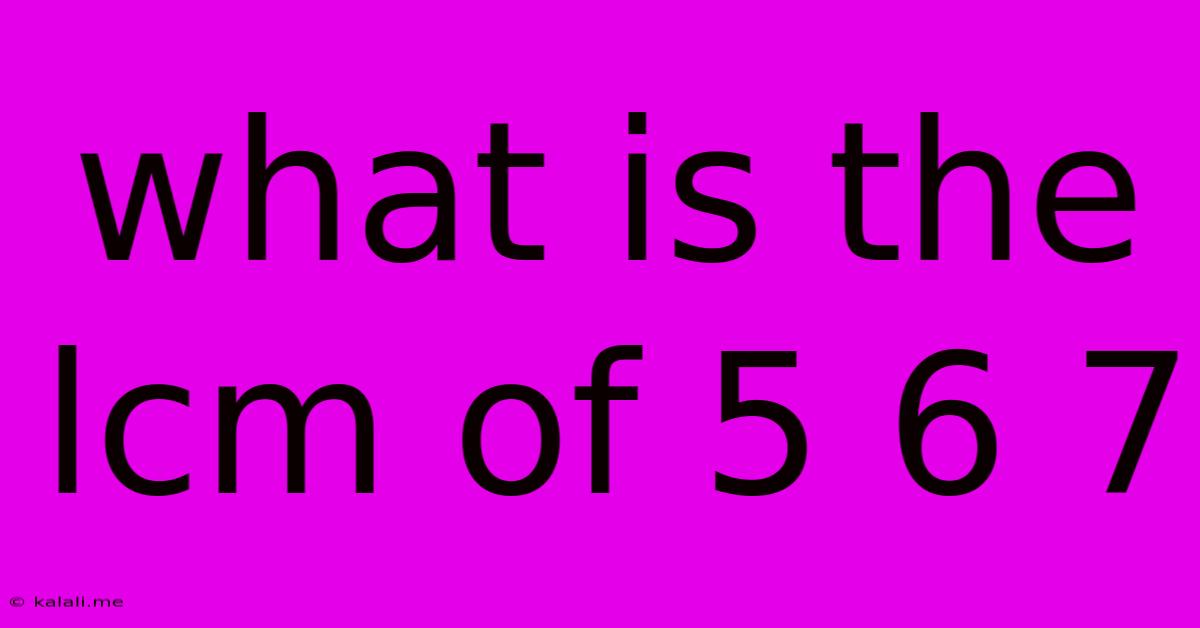What Is The Lcm Of 5 6 7
Kalali
Jun 15, 2025 · 2 min read

Table of Contents
Finding the Least Common Multiple (LCM) of 5, 6, and 7
This article will guide you through calculating the least common multiple (LCM) of 5, 6, and 7. The LCM is the smallest positive integer that is a multiple of all the given numbers. Understanding how to find the LCM is crucial in various mathematical applications, from simplifying fractions to solving problems in algebra and number theory. This simple example provides a clear understanding of the process.
What is the LCM? The least common multiple, or LCM, is the smallest number that is a multiple of two or more numbers. For example, the LCM of 2 and 3 is 6, because 6 is the smallest number that is divisible by both 2 and 3.
Methods for Finding the LCM
There are several ways to find the LCM, but we'll focus on two common methods: the listing method and the prime factorization method. The prime factorization method is generally more efficient for larger numbers.
1. Listing Multiples Method:
This method involves listing the multiples of each number until you find the smallest multiple common to all. Let's try this with 5, 6, and 7:
- Multiples of 5: 5, 10, 15, 20, 25, 30, 35, 40, 45, 50, 55, 60, 65, 70, 75...
- Multiples of 6: 6, 12, 18, 24, 30, 36, 42, 48, 54, 60, 66, 72...
- Multiples of 7: 7, 14, 21, 28, 35, 42, 49, 56, 63, 70, 77...
By examining the lists, we can see that the smallest multiple common to all three numbers is 210. Therefore, the LCM of 5, 6, and 7 is 210. This method works well for smaller numbers but can become tedious with larger numbers.
2. Prime Factorization Method:
This is a more efficient method, especially for larger numbers. It involves finding the prime factorization of each number and then multiplying the highest powers of all the prime factors.
- Prime factorization of 5: 5 (5 is a prime number)
- Prime factorization of 6: 2 x 3
- Prime factorization of 7: 7 (7 is a prime number)
Now, we identify the unique prime factors: 2, 3, 5, and 7. We take the highest power of each prime factor:
- Highest power of 2: 2¹ = 2
- Highest power of 3: 3¹ = 3
- Highest power of 5: 5¹ = 5
- Highest power of 7: 7¹ = 7
Finally, we multiply these highest powers together: 2 x 3 x 5 x 7 = 210.
Therefore, the LCM of 5, 6, and 7 is 210. This method is generally preferred for its efficiency and clarity, especially when dealing with larger sets of numbers or numbers with more complex prime factorizations.
Conclusion:
We've explored two methods to find the least common multiple of 5, 6, and 7. Both methods arrive at the same answer: 210. The prime factorization method is generally recommended for its efficiency and applicability to larger numbers. Understanding how to calculate the LCM is a fundamental skill with broad applications in mathematics.
Latest Posts
Latest Posts
-
Which Of The Following Can Lead To A Tsunami
Jun 16, 2025
-
What Is The Factor Of 74
Jun 16, 2025
-
What Is The Square Root Of 1225
Jun 16, 2025
-
Device Used To Change Ac To Dc
Jun 16, 2025
-
Admission Requirements For West Chester University
Jun 16, 2025
Related Post
Thank you for visiting our website which covers about What Is The Lcm Of 5 6 7 . We hope the information provided has been useful to you. Feel free to contact us if you have any questions or need further assistance. See you next time and don't miss to bookmark.